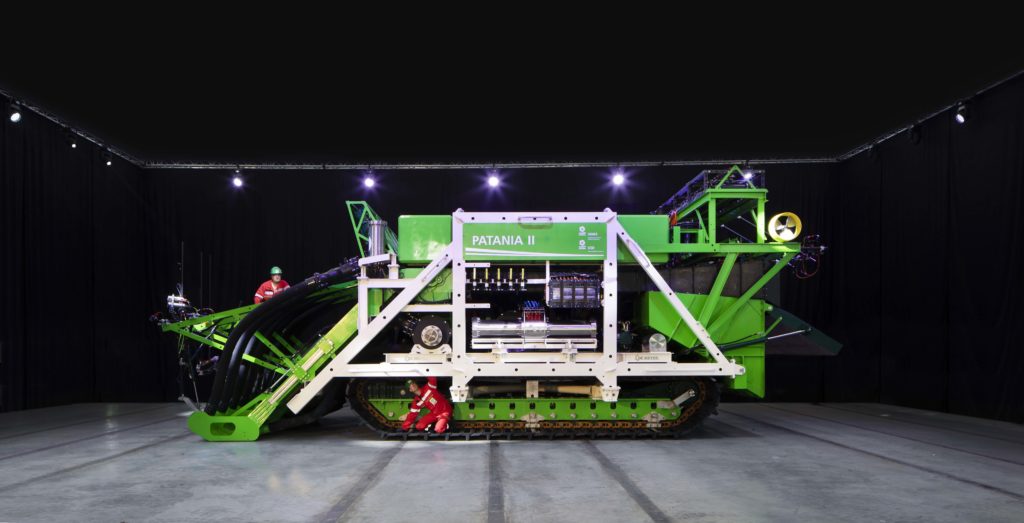
The Belgian company Global Sea Mineral Resources (GSR) had planned to start small-scale testing last month of a bus-sized tracked robot – 40 feet long, 13 feet wide, and 15 feet high – designed to vacuum up poly-metallic nodules from the seafloor of the Clarion-Clipperton Zone. That is an area of the Pacific that stretches from east of Hawai‘i to west of Mexico and which has been eyed for years as a new source of metals to feed the world’s growing demand.
But the launch of the machine, dubbed the Patania II, has been delayed until sometime later this year, GSR has said, after a vital cable connecting the robot to a surface support vessel was damaged. According to the website of GSR’s parent company, DEME Group, the damage occurred “during functionality testing” ahead of the proposed launch.
“The cable, known as an umbilical, is 5 kilometers in length and contains specialized wiring to power, control, and communicate with Patania II … as well as to hold Patania II’s 25-ton weight. … [R]egrettably, GSR has concluded that it will need to postpone the launch of Patania II for a few months.”
Accompanying the deployment of the Patania II will be a team of independent scientists from institutions in 10 European countries and Jamaica. From a separate ship, they will monitor the impacts of the mining effort, with the results of their work being used by GSR to develop an environmental impact statement in anticipation of large-scale mining.
One of the inevitable consequences of seafloor mining is the release of giant clouds of sediment in waters that, as University of Hawai‘i benthic ecologist Craig Smith has said, “are the most particle-free bottom waters in the world’s ocean.”
As a result, “the biota and ecosystem processes are likely to be extremely sensitive to increased suspended sediment concentrations,” Smith stated in an email to Environment Hawai‘i . The effect on marine life will be locally devastating, with the feeding and respiratory structures of animals living in the sediment buried by the sediment stirred up by the mining processes, while animals that live on or depend on the nodules themselves will be destroyed.
One of the scientists involved in the team that will be monitoring the test of the Patania II is Andrea Koschinsky, a geochemist at Jacobs University in Bremen. In an article that appeared in the March 15 edition of Science, Koschinsky minimizes the risk it poses to the seafloor ecosystem. “Most of the silt particles” that will be stirred up by the mining operation, she told Science, “will clump together and fall out within a kilometer or two.”
“That’s a bit misleading,” Smith says. “Whereas some plume models suggest that most of the sediments will drop out within a kilometer or two of the mining, the bottom waters in the Clarion-Clipperton Zone are so clear that if even a very small percentage of the re-suspended sediment stays in the water column, it is likely to have major impacts.
“The most recent models of plume dispersal from 10 days of simulated mining indicate that suspended sediment concentrations and sediment accumulation rates will be four orders of magnitude – 10,000 times – greater than background levels as far as 10 kilometers from the site of the mining.”
In 2015, a team of scientists from Scotland and Germany looked at the natural currents that exist at the seafloor in the CCZ area proposed for mining. At times, the currents can be increased, but there is little disturbance of the sediment. However, should the sediment be disturbed by mining, the currents would be able to disperse the suspended particles over a wide area.
Or, as the authors state, “During eddy-induced elevated flow periods mining-related plumes, potentially supplemented by natural sediment resuspension, are expected to spread and disperse more widely and rapidly,” they concluded. (See Dmitry Aleynik et al., “Impact of remotely generated eddies on plume dispersion at abyssal mining sites in the Pacific,” published online in Nature/Scientific Reports, December 5, 2017.)
“The natural level of background sedimentation in the Central Pacific, accumulated during one thousand years (1-6 mm) is reached within just 10 days” under one of the mining scenarios modeled by Aleynik’s team. “The re-deposition of plume [particles] at this scale is expected to have a huge impact on the generally non-resilient deep ocean ecosystems, which could be prone to irreversible changes under such enormous pressure.”
— Patricia Tummons
For more on the proposals to mine the CCZ, see the interview with Craig Smith in the January 2019 Environment Hawai‘i: “Treasures of Pristine Ocean Ecosystems Could Be Lost to Mining for Metal Nodules.”
If you like what we do, please consider supporting Environment Hawai‘i with a tax-deductible donation.

Leave a Reply